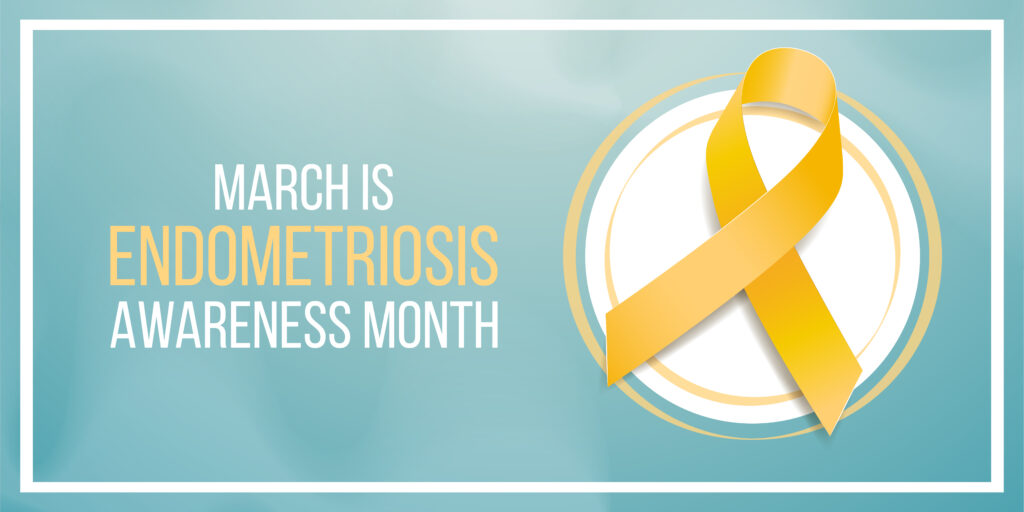Endometriosis Awareness Month


During Endometriosis Awareness Month this March, it’s a good time to evaluate whether or not you may have endometriosis. This condition is fairly common in women. In the U.S. alone it is estimated that 1 in 10 women between the ages of 15 and 44 suffer from endometriosis. This condition happens when tissue similar to the tissue that lines the uterus grows outside of the uterus, most commonly on the ovaries, fallopian tubes, tissues that hold the uterus in place, the outer surface of the uterus, vagina, cervix, vulva, bowel, bladder, or rectum.
While these growths are not cancerous, they can still cause lots of issues. Endometriosis growths may swell and bleed in the same way the lining inside of your uterus does during your period, and this can cause pain and swelling because the tissue is growing and bleeding in an area where it cannot easily get out of your body. The growths may also continue to expand and cause problems like blocking your fallopian tubes, trapping blood in the ovaries which can create cysts, inflammation, forming scar tissue that can cause pain and issues getting pregnant, and problems in your intestines and/or bladder.
Because this condition can cause so many issues, it’s important to know and look out for the symptoms in yourself or even your daughter and see your provider if you believe you may be suffering from this condition. The symptoms for endometriosis can include:
- Very painful menstrual cramps
- Chronic (long-term) pain in the lower back and pelvis
- Pain during or after sex
- Intestinal pain
Painful bowel movements or pain when urinating during menstrual periods - Bleeding or spotting between menstrual periods
- Infertility, or not being able to get pregnant
- Stomach (digestive) problems like diarrhea, constipation, bloating, or nausea, especially during menstrual periods.
https://www.womenshealth.gov/a-z-topics/endometriosis
Managing High Cholesterol 

If you’ve been diagnosed with high cholesterol, you may be overwhelmed with the amount of information you receive about your condition and what you need to do. Any new condition can bring on information overload, but it’s important to remember that managing something like high cholesterol can be broken down into a few easy steps.
- Take your medicine as directed. Depending on your cholesterol levels, your provider may prescribe you medicine to help lower it. It’s important to follow your provider’s instructions for the medication carefully and not to stop taking it without consulting your healthcare team. Don’t be afraid to ask your nurse, provider, or pharmacists any questions you may have about the medication.
- Make healthy lifestyle changes. This can often seem like the most overwhelming part of managing a chronic condition like high cholesterol, but don’t overthink it. Incorporating more whole grains and vegetables into your diet, choosing foods lower in saturated and trans fat, and reducing your sugar consumption can make a big difference.
- Talk with your healthcare team. Your healthcare team is just that–a team. You are all working together to manage your high cholesterol, so be sure to discuss your treatment plan regularly and ask any questions you may have at your appointments.
- Check your cholesterol regularly. Your cholesterol levels will determine how frequently you need to have your cholesterol checked. Talk with your provider about the timeline that is best for you.
https://www.cdc.gov/cholesterol/managing-cholesterol.htm
Oven Fried Chicken 

Ingredients:
- 1 lemon
- ½ cup low-fat milk
- ½ teaspoon granulated sugar
- ¼ teaspoon cayenne pepper
- 2 teaspoons chopped fresh rosemary, plus two whole sprigs
- 4 cloves garlic, peeled and smashed
- 2 pounds bone-in, skinless chicken legs and thighs
- 2 slices whole wheat bread (3 ounces)
- ¼ cup yellow cornmeal
- 2 tablespoons grated parmesan cheese (optional)
- Salt and black pepper
Directions:
Step One: Finely grate 1 teaspoon of zest from the lemon; set aside. Squeeze the juice of the lemon into a medium bowl. Whisk in the milk, sugar, and cayenne until the sugar and cayenne are dissolved. Add the sprigs of rosemary and garlic. Pierce each chicken piece several times with a fork, add to the milk mixture, turning to coat well. Cover, and marinate in the refrigerator for 2 hours.
Step Two: Meanwhile, preheat the oven to 300 degrees. Lay the bread on a baking sheet in a single layer. Bake, turning a few times, until the bread is crisp and dry, 45 minutes to 1 hour. Cool completely. Break into large pieces and pulse in the bowl of a food processor until it forms coarse crumbs.
Step Three: Increase the oven temperature to 375 degrees. In a shallow dish combine the bread crumbs with the cornmeal, Parmesan (if using), chopped rosemary, reserved 1 teaspoon zest, and season with salt and pepper. Line a baking sheet with aluminum foil and top with a wire rack. Coat the rack well with nonstick cooking spray.
Step Four: Working with one piece at a time, remove the chicken from the marinade, allowing the excess to drip off. Press into the bread crumb mixture until the chicken is well coated and place on the prepared baking sheet. Repeat with the remaining chicken and crumbs. Mist the chicken with nonstick cooking spray.
Step Five: Bake until the chicken is crisp and a thermometer inserted into the thickest part registers 160 degrees F, about 50 to 55 minutes. Serve warm or at room temperature.
https://www.foodnetwork.com/recipes/food-network-kitchen/oven-fried-chicken-recipe4-2040678






